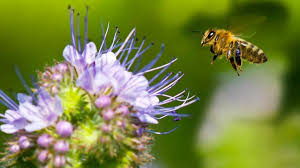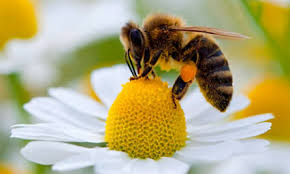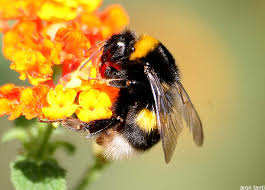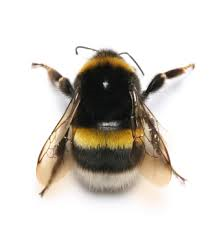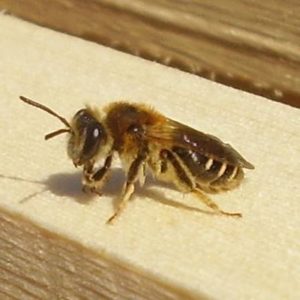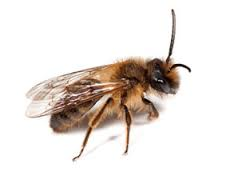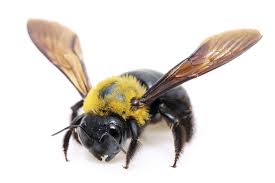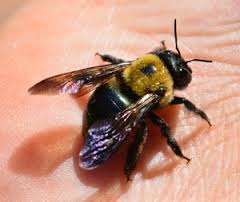Continuation types of stingers:
2.) Bees
A.) Honeybees
Honey bees have been around longer than humans; there is fossil evidence from 150 million years ago!Honeybees are highly social insects. Honeybees can contain up to 60,000 bees in its colony at its peak. Honeybees can fly up to 15 miles an hour. Worker bees are sexually undeveloped females. They build hives, forage for pollen and nectar for food and circulate air within the hive by beating their wings, among other tasks. The queen’s main job is to lay eggs, though she also directs activity within the hive. Male bees are called drones. In winter months when the hive needs to conserve resources, drones are expelled. Honeybees can only sting once, causing the
bee to die, as the stinger and the venom sack get stuck in the victim’s flesh after use.
Many people are afraid of bees because they think they will be stung by them, but bees are far more interested in going about their business foraging for pollen and nectar than they are in ‘stinging’ human beings. It actually takes a lot to provoke a bee to sting you – and many of our UK bees don’t sting at all.
| Honeybee (Apismellifera) |
Honeybees…….
will sting if defending their honey stores or their queen, or if they think you are threatening their life by standing or sitting on them.
Honeybees have a barb at the end of their sting which remains under your skin after they have stung.When a honey bee stings a person, it cannot pull the barbed stinger back out. It leaves behind not only the stinger, but also part of its abdomen and digestive tract, plus muscles and nerves. Honey bees, including killer bees, have barbed stingers that tear off when they try to fly away after stinging, so these bees die after the sting and thus can sting only one time. In this case the stinger and venom sac typically remain embedded in the skin of the victim.This massive abdominal rupture kills the honey bee. Honey bees are the one of the few species of bees to die after stinging.They usually dieright after they have stung.
It is worth noting that honeybees have a somewhat variable temperament, from extremely docile to quite tetchy. This is down to genetics: certain crosses can be hard to handle, even by experienced beekeepers. The good news is that honeybees almost never sting anyone who is not close to their nest/hive, so don’t worry about being stung whilst gardening or walking through a field.
You are less likely to be stung whilst honeybees are swarmingthan at any other time.
Male honeybees have no sting
If you have reason to think you may be allergic to bee venom, you should carry an Epipen (A PREPARED EPINEPHRINE DOSE WITH A NEEDLE to prevent anaphylactic reaction.)
B.) Bumblebees
Like their relatives the honey bees, bumblebees feed on nectar, using the long hairy tongue (proboscis) to lap up the liquid; the proboscis is folded under the head for flight. Bumblebees gather pollen to feed their young
Theywill only sting if their nest is threatened or if you squeeze them, sit on them or stand on them. They are not naturally aggressive and it takes a lot to provoke them. If they feel threatened by you they will ‘tell’ you. They do this by raising one of their middle legs in the air. When you move away they will put their leg back down again – but if you go closer (and if they are unhappy about this) they will lift another leg in the air. If you go closer still – they will lift two legs up vertically in the air or turn on their back and show you their sting! This is called ‘posturing’ but very rarely leads to them actually stinging you. If bumblebees DO ever sting, their sting has no barb like the honeybee, so they will not die afterwards 🙂
Male bumblebees do not have a sting. You can identify the males of some species quite easily by their pale yellow facial hair and little yellow moustaches. Also, male bumblebees are in less hurry than the females when foraging and have thin hairy legs (females have a wide shiny, smooth top corbicula on their back legs and are often carrying pollen)
C.) Solitary bees
There are over 230 species of solitary bee in the UK and it is VERY rare for anyone to be stung by one of these bees. As solitary bees have no honey stores to protect, there is no reason for nature to have provided them with a good defence weapon like the honeybee. The females are equipped with tiny stings but rarely, if ever, do they use them. You would have to be squashing them to provoke them to sting – and even then, the sting is so insignificant that it cannot pierce human skin.
There are just one or two exceptions. Although the effect is not as severe as a honeybee sting, our tiniest species of ground nesting solitary bee, Lasioglossum and Halictus, both have fully functioning stings capable of penetrating human skin.
None of the male solitary bees have stings.
D.)Carpenter Bees
Carpenter bees, also dubbed the ‘wood boring bee’ got their name from their ability to drill through wood and nest inside the hole that they drilled. These bees are honestly some of the most amazing bees in the world due to the fact that their hole is almost always nearly perfectly the same size: a half of an inch in diameter. How many insects can make a near perfect circle in a piece of wood? Not many and that is why the carpenter bee is one of the most interesting bees in the world … next to the honey bee of course!
There are many different ways to tell a carpenter bee from other bees. The adult body length is usually about one half of an inch to about one inch and they are so robust they even resemble the bumble bee a little bit. The top surface of the abdomen on the carpenter bee is almost bare and it is going to be shiny. You can tell a male from a female by the color of their face: the male is going to have a yellow face while the female is always going to have a black face. These bees are usually bare and shiny black, though some have a few little yellow markings on the rear.
Carpenter bees can be pollinators as well, so some people offer them bee-homes in their gardens with pre-drilled wood houses.
You will notice many different signs of carpenter bees if you have an infestation at your home. For example, you will begin to notice holes in all of your wooden surfaces, as this is where the carpenter bees will make their nest. This can be in any wood surface anywhere from siding, overhangs, desks, fences and even window frame! Carpenter bees are definitely bees that you should get rid of and not linger on, the longer you wait to get rid of these bees, the more wood they are going to infest.
If you are looking for a way to stop the carpenter bees from entering your home and getting to your wood, simply treat your wood. Bare and unpainted wood is definitely something that carpenter bees look for, especially redwood, cedar, cypress and pine. If you cure your wood and make sure to put down some carpenter bee preventative, you should have absolutely no problems with these bees getting anywhere near your wood.
So as you can see, these bees are not only some of the most annoying bees to homeowners but they are pretty interesting too. It is not often that you run into an insect that can drill through wood and seeks to make their nest in wood. Just make sure that you take these few steps in order to prevent these amazing creatures from ruining your wood and you should have no problems with these amazing insects! Just a quick coat of paint or even just a quick coat of stain will definitely protect your wood from being infested with carpenter bees or any other kind of weather issues. Just remember that if you do not treat your wood in the spring, you could end up with carpenter bees!
COME BACK TOMORROW FOR PART 3 HOW TO TREAT A STING with KNOWING THE SEVERITY OF THE REACTION & WHAT TO DO!
